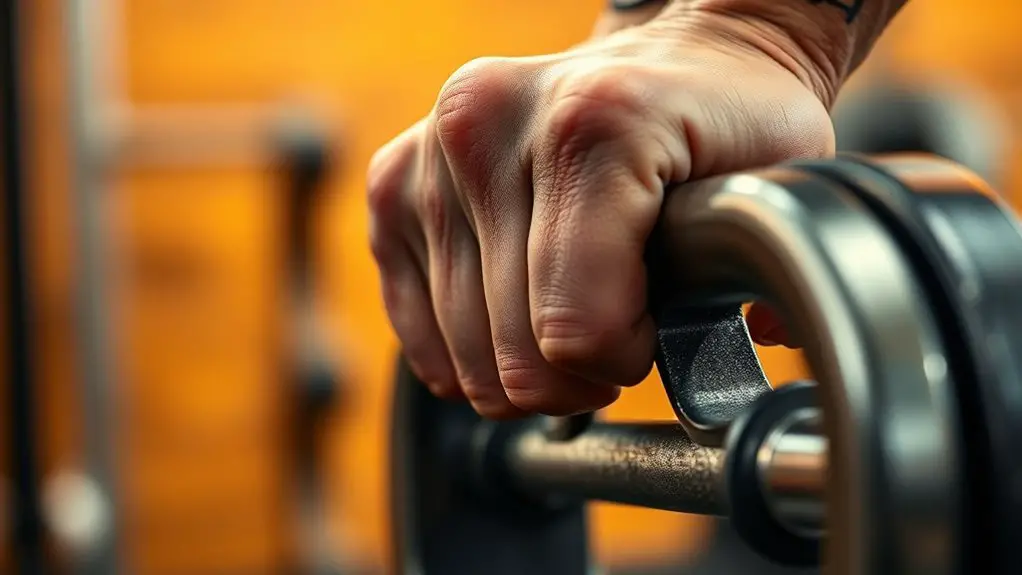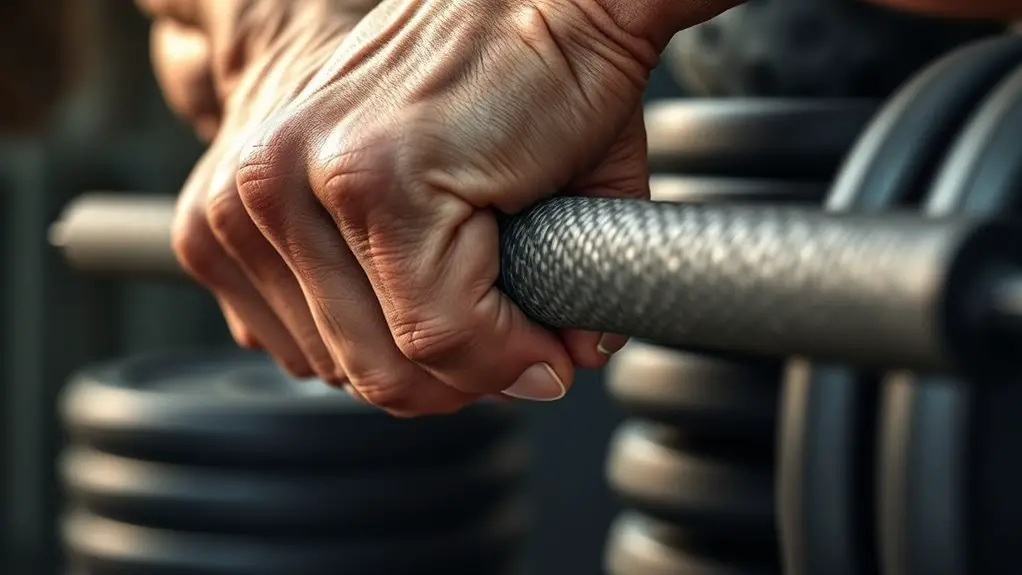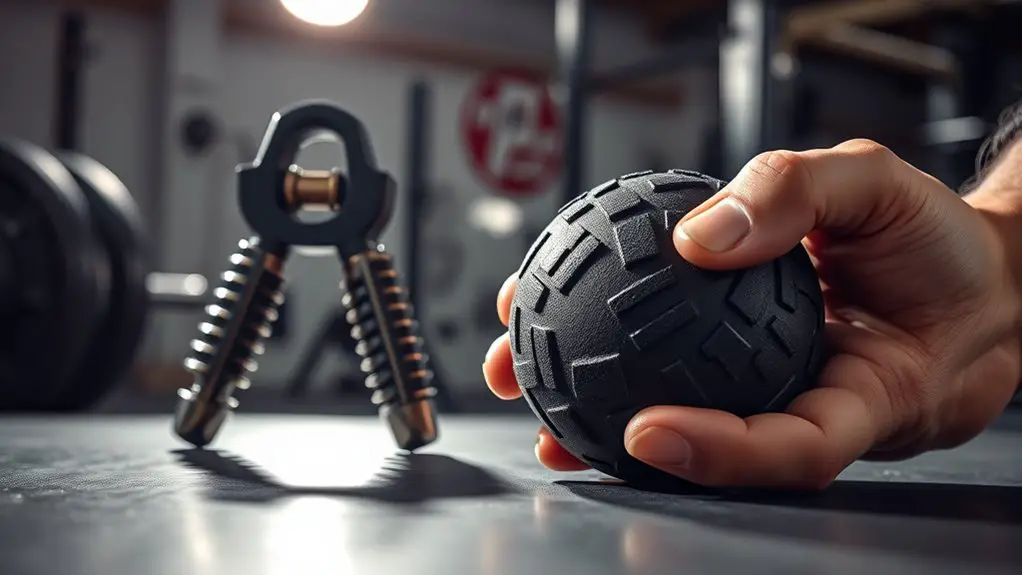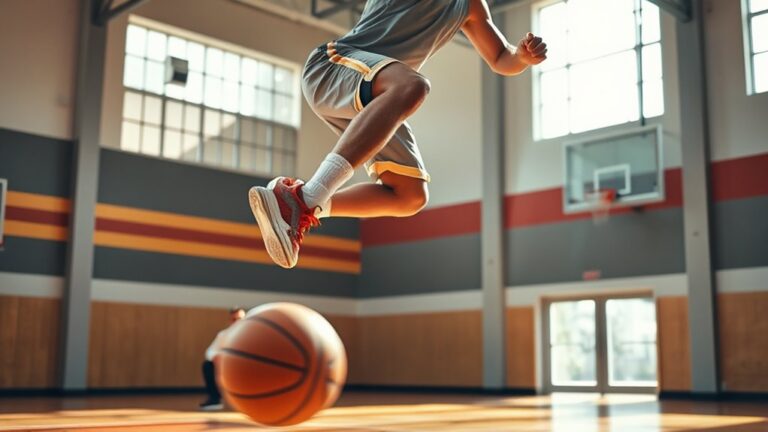How to Increase Grip Strength for Heavy Lifting

To increase your grip strength for heavy lifting, prioritize exercises like the Farmer’s Walk, Dead Hang, and Plate Pinch Holds. Consistently integrate these into your routine, especially after heavy lifts. Use grip trainers or varying weights to challenge yourself. Don’t forget the importance of nutrition and recovery strategies, including adequate protein intake and hydration. Set realistic goals for gradual progress. With a structured approach to grip training, you’ll see significant improvements in your performance and safety during lifts. Keep going to discover more strategies for enhancing your grip strength.
Understanding Grip Strength and Its Importance

While many lifters focus on developing major muscle groups, grip strength often gets overlooked, yet it’s vital for overall performance and safety in heavy lifting. Understanding grip anatomy is fundamental; your grip consists of various muscles and tendons that enable you to hold and control weights effectively. There are several grip types—such as the overhand, underhand, and mixed grip—each influencing how force is transmitted through your hands and into the barbell or dumbbell.
A strong grip stabilizes your lifts, allowing you to maximize weight and reduce the risk of injury. It’s not just about lifting heavier; a solid grip supports proper technique and form, ensuring you can effectively engage your target muscles. By prioritizing grip strength alongside your major lifts, you’ll enhance your overall training and release your potential in the gym.
Essential Grip Strength Exercises
To build your grip strength effectively, you need to incorporate specific exercises that target different aspects of grip. The Farmer’s Walk, Dead Hang, and Plate Pinch Hold are essential movements that can enhance your performance in heavy lifting. Each of these exercises offers unique benefits that contribute to overall grip development.
Farmer’s Walk Technique
The Farmer’s Walk is an excellent exercise for improving grip strength, as it not only challenges your hands but also engages your core and lower body. To perform it correctly, grab a pair of heavy dumbbells or kettlebells, standing tall with your feet shoulder-width apart. Keep your shoulders back, and engage your core as you lift the weights off the ground. Maintain a neutral spine while walking forward for a set distance or time. Proper form is essential to avoid injury and maximize farmer’s walk benefits. Remember to keep your arms straight and avoid swinging the weights. Incorporate this exercise into your routine to enhance grip strength and overall stability, paving the way for heavier lifting in your training.
Dead Hang Benefits
A dead hang is a simple yet effective exercise for boosting grip strength, and it’s often overlooked in many training regimens. By hanging from a pull-up bar, you engage your forearm muscles, enhancing your grip endurance. To maximize benefits, experiment with dead hang variations, such as towel hangs or one-arm hangs, which further challenge your grip. Focus on increasing your grip hang duration; aim for 30 to 60 seconds initially, gradually extending as your strength improves. This exercise not only strengthens your grip but also promotes shoulder stability and improves overall core strength. Incorporating dead hangs into your routine can lead to significant gains in your lifting performance and help prevent injuries.
Plate Pinch Hold
One of the most effective exercises for enhancing grip strength is the plate pinch hold, which targets the fingers and the thumb while also engaging the forearm muscles. To perform this exercise, grasp two weight plates by their edges and hold them together, ensuring your fingers and thumbs are doing the work. Start with lighter plates and gradually increase the weight as your grip endurance improves. You can also incorporate plate pinch variations, such as holding the plates for longer durations or using different plate sizes, to further challenge your grip. Aim for sets lasting 20 to 60 seconds, resting between attempts. This exercise not only strengthens your grip but also translates well to heavy lifting in various sports and activities.
Incorporating Grip Training Into Your Routine
Incorporating grip training into your routine can markedly enhance your overall lifting performance. Start by dedicating a few minutes at the end of your workouts to focus on specific grip training techniques. You can integrate exercises like farmer’s walks or static holds, which challenge grip strength in practical scenarios. It’s crucial to explore various grip strength variations, such as using different hand positions—overhand, underhand, and neutral grips—to target different muscle groups.
Consider alternating grip-focused workouts with your regular lifting sessions, ensuring you’re not overtraining. For instance, on days when you perform deadlifts or rows, add a grip training exercise afterward. This approach will keep your grip strength improving without compromising your main lifts. Remember, consistency is key, so schedule these sessions weekly to build a stronger grip over time. Embrace these techniques, and watch your lifting capacity grow considerably.
Tools and Equipment for Grip Strengthening

Several tools and equipment can greatly enhance your grip strength training regimen. Grip trainers and hand grippers are excellent for isolating your grip muscles, allowing you to progressively increase resistance. Incorporating grip balls into your routine can help develop overall hand strength. For added versatility, resistance bands can be used for finger extensor exercises, targeting the often-neglected muscles.
Using chalk can improve your grip during heavy lifts, minimizing slippage. Weight plates, when pinched between your fingers, are effective for building grip strength. Wrist rollers provide dynamic resistance, engaging multiple muscle groups simultaneously. To enhance comfort and performance, consider grip pads and grip socks, which can improve your stability during various exercises. Each tool offers unique benefits, so combining them will yield the best results for your grip strength development.
Nutrition and Recovery for Optimal Grip Performance
While tools and equipment enhance grip strength, nutrition and recovery play a critical role in maximizing your performance. To optimize your grip, focus on meal planning that emphasizes adequate protein sources and proper nutrition timing. Incorporate recovery techniques, such as stretching and foam rolling, to aid muscle recovery after intense lifting sessions. Additionally, consider showering before workouts as a way to enhance your overall gym experience and prepare your body for lifting.
Here’s a quick guide to effective strategies:
| Strategy | Details | Impact on Grip Strength |
|---|---|---|
| Supplement Choices | Creatine, BCAAs | Supports muscle recovery |
| Hydration Strategies | Electrolyte balance | Enhances performance |
| Recovery Techniques | Stretching, foam rolling | Reduces injury risk |
Implementing these strategies will guarantee your diet’s impact positively supports your training efforts. Prioritize hydration and consider your supplement choices to fully leverage your grip strength potential.
Tracking Progress and Setting Goals
To effectively track your grip strength progress, start by establishing baseline measurements using tools like a dynamometer. Once you have this data, set incremental goals that are specific and achievable to keep your training focused. Regularly reassess your grip strength to adjust these goals as needed, ensuring continued improvement.
Establishing Baseline Measurements
Establishing baseline measurements is essential for tracking your grip strength progress and setting attainable goals. To begin, conduct baseline testing using a reliable grip dynamometer. This device accurately measures your grip strength, providing objective data for your initial readings. Make certain to perform multiple tests on both hands to guarantee consistency in your grip measurements. Document these results, as they will serve as your starting point. Additionally, consider measuring your grip strength during different exercises, like deadlifts or pull-ups, to gain a thorough understanding of your capabilities. By having these baseline measurements, you can effectively monitor your improvements over time and adjust your training regimen accordingly to enhance your grip strength for heavy lifting.
Setting Incremental Goals
Setting incremental goals is essential for effectively improving your grip strength over time. Begin by identifying specific metrics, like the weight you can hold or the duration of your grip. Use these metrics to design a plan that incorporates goal progression; for instance, aim to increase your grip weight by 5-10% every few weeks. This structured approach helps you track progress and maintain motivation. Embrace a perseverance mindset, understanding that setbacks are part of the process. As you achieve each goal, reassess and set new targets to continue challenging your grip strength. By consistently pushing your limits, you’ll develop not only stronger grips but also enhanced resilience in your lifting journey.
Frequently Asked Questions
Can Grip Strength Improve Overall Athletic Performance?
Imagine a tree’s roots; the stronger they are, the taller and sturdier the tree grows. Similarly, grip strength can enhance your athletic performance. By incorporating grip exercises into your training, you’ll see improvements in overall athletic conditioning. Studies show that athletes with better grip strength often excel in various sports, as it aids in stability and control. So, don’t underestimate the power of a solid grip; it’s the foundation for your success!
How Long Does It Take to See Grip Strength Improvements?
You might notice improvements in grip strength within a few weeks of consistent training. The exact timeline depends on your training frequency and the intensity of your exercises. If you’re training regularly, you can expect to see measurable strength progression as your muscles adapt. Typically, it takes about 4 to 8 weeks for significant gains, but individual results may vary based on your baseline strength and commitment to your regimen.
Are There Specific Diets to Enhance Grip Strength?
There aren’t specific diets solely for enhancing grip strength, but a balanced diet can help. Focus on protein sources like lean meats, legumes, and dairy to support muscle repair and growth. Incorporating dietary supplements like creatine or branched-chain amino acids (BCAAs) might also aid in strength development. Staying hydrated and ensuring adequate micronutrient intake, especially magnesium and zinc, can further optimize your overall performance and potentially improve grip strength over time.
Is Grip Strength Training Safe for Beginners?
Yes, grip strength training is safe for beginners if you follow some safety precautions. Start with beginner techniques like using light weights or grip trainers to avoid overexertion. Gradually increase resistance as your strength improves. Always warm up your hands and wrists before starting any exercises, and listen to your body—stop if you feel pain. By incorporating these practices, you can build grip strength effectively while minimizing the risk of injury.
Should I Train Grip Strength Daily or Weekly?
You might wonder if you should train grip strength daily or weekly. While daily training can enhance endurance and muscle adaptation, it may lead to overuse injuries if not managed properly. On the other hand, weekly training allows for recovery, enabling you to focus on intensity and improving your grip efficiently. A balanced approach, alternating between daily and weekly sessions, can help maximize results while keeping your hands healthy and strong.





